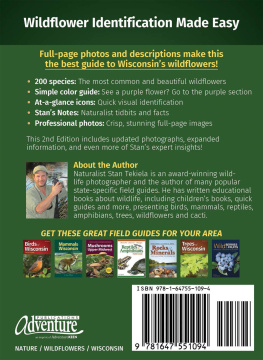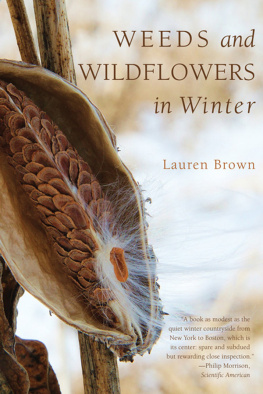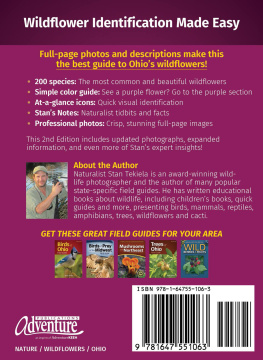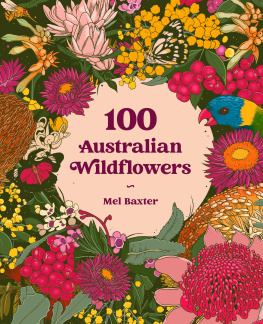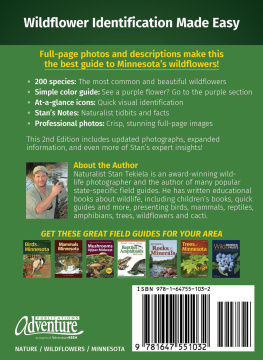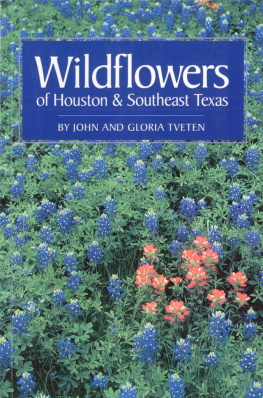
TEXAS WILDFLOWERS

TEXAS NATURAL HISTORY GUIDESTM
TEXAS WILDFLOWERS
A FIELD GUIDE
Revised Edition
Campbell and Lynn Loughmiller
Lynn Sherrod, Technical Editor
Updated by Damon Waitt, Lady Bird Johnson Wildflower Center
Foreword to the First Edition by Lady Bird Johnson

Copyright by the University of Texas Press
Revised edition, 2006
First edition, 1984
All rights reserved
Printed in China
Requests for permission to
reproduce material from
this work should be sent to:
Permissions
University of Texas Press
P.O. Box 7819
Austin, TX 78713-7819
www.utexas.edu/utpress/about/bpermission.html
The paper used in this book
meets the minimum requirements
of ANSI/NISO39.48-1992 (R1997)
(Permanence of Paper).
LIBRARY OF CONGRESS CATALOGING-IN-PUBLICATION DATA
Loughmiller, Campbell.
Texas wildflowers : a field guide / Campbell and Lynn Loughmiller.Rev. ed., Rev. and updated / by Damon Waitt.
p. cm. (Texas natural history guides)
Includes bibliographical references (p. ) and index.
ISBN 0-292-71286-3 (cloth : alk. paper)
1. Wild flowersTexasIdentification.
I. Loughmiller, Campbell. II. Loughmiller, Lynn. III. Waitt, Damon Edward, 1961IV. Title. V. Series.
QK188.L68 2006
582.1309764dc22
2005023299
CONTENTS
Damon Waitt
Lady Bird Johnson
Campbell Loughmiller
Acanthus or Wild Petunia Family
Yucca, Century-Plant, or Agave Family
Water-Plantain or Arrowhead Family
Pigweed Family
Sumac or Cashew Family
Parsley or Carrot Family
Dogbane or Oleander Family
Arum or Calla Family
Milkweed Family
Sunflower or Daisy Family
Barberry Family
Catalpa Family
Borage or Forget-Me-Not Family
Mustard Family
Cactus Family
Bluebell or Lobelia Family
Caper or Spiderflower Family
Honeysuckle Family
Pink Family
Dayflower or Spiderwort Family
Morning-Glory Family
Dogwood Family
Gourd Family
Sundew Family
Heath Family
Spurge Family
Legume, Pea, or Bean Family
Ocotillo or Candlewood Family
Fumitory or Bleeding-Heart Family
Gentian Family
Geranium Family
Buckeye Family
Waterleaf Family
Iris Family
Rhatany or Krameria Family
Mint Family
Bladderwort or Butterwort Family
Lily Family
Flax Family
Stickleaf Family
Logania or Strychnine Family
Loosestrife or Crape-Myrtle Family
Magnolia Family
Mallow Family
Unicorn-Plant Family
Meadow-Beauty Family
Four-OClock Family
Water-Lily Family
Olive Family
Evening-Primrose Family
Orchid Family
Wood-Sorrel Family
Poppy Family
Passionflower Family
Pokeweed Family
Phlox Family
Milkwort Family
Smartweed, Knotweed, or Buckwheat Family
Pickerelweed Family
Purslane Family
Primrose Family
Buttercup or Crowfoot Family
Rose Family
Madder or Coffee Family
Soapberry Family
Pitcher-Plant Family
Figwort, Snapdragon, or Foxglove Family
Potato or Nightshade Family
Storax Family
Camellia Family
Vervain Family
Violet Family
Caltrop Family
NOTES ON THE REVISED EDITION
Welcome to the revised edition of Texas Wildflowers: A Field Guide, by Campbell and Lynn Loughmiller. A lot can change in 22 years, not the least of which are the names we associate with the wildflowers in the first editionbut we will come to that shortly.
Since the Loughmillers guide was first published in 1984, more than 155,000 copies of Texas Wildflowers have been sold, placing it among the top three best sellers for the University of Texas Press. Those who subscribe to the If it aint broke, dont fix it philosophy might question the reasons for a new edition, especially one that departs so radically in appearance from the first. Lets start by judging the book by its cover, literally. The cover stock is made of a much more durable material to ensure longer life in the field, and the book is a bit narrower, to facilitate carrying it in a pack or pocket. These physical changes are all part of the University of Texas Press plan to develop a complete series of natural history field guides, covering everything that creeps, crawls, runs, swims, flies, or grows in our fair state. Texas Wildflowers is the second book published in this University of Texas Press natural history series.
Within the pages of this edition, great care was taken to preserve the spirit of the original text, including the original foreword written by Lady Bird Johnson. In it, she refers to the National Wildflower Research Center founded in 1982 on a farm-to-market road near Austin. In 1995, the National Wildflower Research Center moved to a 43-acre site off Loop 1 (MoPac) in south Austin. Shortly thereafter, the name was changed to honor the centers cofounder and chairperson. Today, the Lady Bird Johnson Wildflower Centers 279-acre site serves as a model native plant botanic garden with programs that protect, conserve, and restore our natural plant heritage. It is a must-see if you are ever in the Austin area.
One feature that made the first edition especially appealing was the abundance of personal observations found throughout the books introduction and species descriptions. The Loughmillers observations have been retained in the revised edition whenever possible, unless they conflicted with taxonomic revisions or described photographs not appearing in this edition. Sadly, Campbell Loughmiller passed away in 1992, and Lynn followed her husband in 2001. Pioneering conservationists, Campbell and Lynn Loughmiller will be remembered for their kindness, gentle humor, and humanitarian ideals.
Although, as Campbell Loughmiller noted in his introduction to the first edition, it is not necessary to know the name of a flower in order to appreciate it, it is important to keep up to date and to be consistent in the application of scientific names. For example, in the first edition several plant families are referred to by their traditional family names (Umbelliferae, Compositae, Cruciferae, Leguminosae, and Labiatae). Under a rule of botanical nomenclature called nomina conservanda (conservation of names), tradition allows these family names to be used in place of their modern equivalents (Apiaceae, Asteraceae, Brassicaceae, Fabaceae, and Lamiaceae). In this edition, we opted to use the standardized family names (those ending in aceae). Since the field guide is arranged alphabetically by plant family, that simple change had a cascading effect on the second editions organization.
The most significant change in the second edition is the application of scientific names to plants. The goal of plant taxonomy is to develop a uniform, practical, and stable system of nomenclature (applying names to plants). These rules are set forth in the International Code of Botanical Nomenclature, and they facilitate international communication and sharing of information about plants. Though names can change if they are found to violate the code, the most significant source of name changes is a better understanding of the evolutionary relationships among plant species. Since modern-day classification is organized to reflect these relationships, new evidence, such as that from molecular genetic studies, can lead to changes in nomenclature.
Next page

